Interdecadal Change in the Relationship between the Winter Siberian High and Summer Tropical Cyclone Genesis Frequency over the Western North Pacific
Abstract
:1. Introduction
2. Data and Methods
3. Relationship between the Winter SH and WNP TCGF in the Following Summer
3.1. Interdecadal Change
3.2. Possible Causes of the Changed Relationship
4. Summary and Discussion
Author Contributions
Funding
Institutional Review Board Statement
Informed Consent Statement
Data Availability Statement
Conflicts of Interest
References
- Huang, R.H.; Huangfu, J.L.; Liu, Y.; Feng, T.; Wu, L.; Chen, J.L.; Wang, L. Progress in Recent Research on the Processes and Physical Mechanisms Involved in the Influence of the Western Pacific Warm Pool on the Monsoon Trough and Tropical Cyclone Activity over the Western North Pacific. Chin. J. Atmos. Sci. 2016, 40, 877–896. (In Chinese) [Google Scholar]
- Chan, J.C.L. Interannual and interdecadal variations of tropical cyclone activity over the western North Pacific. Meteorol. Atmos. Phys. 2005, 89, 143–152. [Google Scholar] [CrossRef]
- Walsh, K.J.; McBride, J.L.; Klotzbach, P.J.; Balachandran, S.; Camargo, S.J.; Holland, G.; Knutson, T.R.; Kossin, J.P.; Lee, T.C.; Sobel, A.; et al. Tropical cyclones and climate change. Clim. Change 2016, 7, 65–89. [Google Scholar] [CrossRef]
- Gray, W.M. Hurricanes: Their Formation, Structure and Likely Role in the Tropical Circulation; Royal Meteorological Society: Reading, UK, 1979; pp. 155–218. [Google Scholar]
- Wand, B.; Chan, J.C.L. How strong ENSO events affect tropical storm activity over the western North Pacific. J. Clim. 2002, 15, 1643–1658. [Google Scholar]
- Wang, C.; Li, C.; Mu, M.; Duan, W. Seasonal modulations of different impacts of two types of ENSO events on tropical cyclone activity in the western North Pacific. Clim. Dyn. 2013, 40, 2887–2902. [Google Scholar] [CrossRef]
- Du, X.G.; Yu, J.H. Contribution of environmental factors to the change of tropical cyclone frequency in the summer of ENSO developing and decaying years. J. Trop. Meteorol. 2020, 36, 244–253. (In Chinese) [Google Scholar]
- Zhan, R.; Wang, Y.; Wu, C. Impact of SSTA in the east Indian Ocean on the frequency of Northwest Pacific tropical cyclones: A regional atmospheric model study. J. Clim. 2011, 24, 6227–6242. [Google Scholar] [CrossRef]
- Zhang, H.J.; Wu, L.; Huang, R.H. Possible impact of two types of El Niño events on the western North Pacific monsoon trough and tropical cyclogenesis. Clim. Environ. Res. 2018, 23, 150–160. (In Chinese) [Google Scholar]
- Wang, C.; Wu, L. Interannual shift of the tropical upper-tropospheric trough and its influence on tropical cyclone formation over the western North Pacific. J. Clim. 2016, 29, 4203–4211. [Google Scholar] [CrossRef]
- Yu, J.; Li, T.; Tan, Z.; Zhu, Z. Effects of tropical North Atlantic SST on tropical cyclone genesis in the western North Pacific. Clim. Dyn. 2016, 46, 865–877. [Google Scholar] [CrossRef]
- Huo, L.; Guo, P.; Hameed, S.N.; Jin, D. The role of tropical Atlantic SST anomalies in modulating western North Pacific tropical cyclone genesis. Geophys. Res. Lett. 2015, 42, 2378–2384. [Google Scholar] [CrossRef]
- Wang, H.J.; Sun, J.Q.; Fan, K. Relationships between the North Pacific Oscillation and the typhoon/hurricane frequencies. Sci. China Ser. D-Earth Sci. 2007, 37, 966–973. (In Chinese) [Google Scholar] [CrossRef]
- Chen, D.; Wang, H.J.; Liu, J.P.; Li, G.P. Why the spring North Pacific Oscillation is a predictor of typhoon activity over the Western North Pacific. Int. J. Climatol. 2015, 35, 3353–3361. [Google Scholar] [CrossRef]
- Bond, N.; Overland, J.; Spillane, M.; Stabeno, P. Recent shifts in the state of the North Pacific. Geophys. Res. Lett. 2003, 30, 2183. [Google Scholar] [CrossRef] [Green Version]
- Alexander, M.A.; Vimont, D.J.; Chang, P.; Scott, J.D. The impact of extratropical atmospheric vatiability on ENSO: Testing the seasonal footprinting mechanism using coupled model experiments. J. Clim. 2010, 23, 2885–2901. [Google Scholar] [CrossRef] [Green Version]
- Yu, J.Y.; Kim, S.T. Relationships between extratropical sea level pressure variations and the central Pacific and eastern Pacific types of ENSO. J. Clim. 2011, 24, 708–720. [Google Scholar] [CrossRef]
- Ding, R.Q.; Li, J.P.; Tseng, Y.H.; Sun, C.; Guo, Y.P. The victoria mode in the North Pacific linking extratropical sea level pressure variations to ENSO. J. Geophys. Res. Atmos. 2015, 20, 27–45. [Google Scholar] [CrossRef]
- Ding, R.Q.; Li, J.P.; Tseng, Y.H.; Ruan, C.Q. Influence of the North Pacific Victoria mode on the Pacific ITCZ summer precipitation. J. Geophys. Res. Atmos. 2015, 120, 964–979. [Google Scholar] [CrossRef]
- Wallace, J.M.; Gutzler, D.S. Teleconnections in the Geopotential Height Field during the Northern Hemisphere winter. Mon. Wea. Rev. 1981, 109, 7842–8812. [Google Scholar] [CrossRef]
- Cohen, J.; Sait, K.; Entekhabi, D. The role of the Siberian high in northern hemisphere climate variability. Geophys. Res. Lett. 2001, 28, 299–302. [Google Scholar] [CrossRef] [Green Version]
- Gong, D.Y.; Ho, C.H. Siberian High and climate change over middle to high latitude Asia. Theor. Appl. Climatol. 2002, 72, 1–9. [Google Scholar] [CrossRef]
- Ding, Y.H. Build-Up, Air Mass Transformation and Propagation of Siberian High and its Relations to Cold Surge in East Asia. Meteorl. Atmos. Phys. 1990, 44, 281–292. [Google Scholar]
- Miyazaki, S.; Yasunari, T.; Adyasuren, T. Abrupt Seasonal Changes of Surface Climate Observed in Northern Mongolia by an Automatic Weather Station. J. Meteorol. Soc. Jpn. 1999, 77, 583–593. [Google Scholar] [CrossRef] [Green Version]
- Wu, B.; Wang, J. Winter Arctic Oscillation, Siberian High and East Asian winter Monsoon. Geophys. Res. Lett. 2002, 29, 3-1–3-4. [Google Scholar] [CrossRef]
- Fu, J.Y.; Liu, M.H.; Wang, R.; Wang, Y.W.; Zhao, S. Possible Impact of Boreal Winter Siberian High on ENSO Development in the Following Year. Front. Earth Sci. 2022, 10, 885846. [Google Scholar] [CrossRef]
- Yang, L.; Du, Y.; Xie, S.P.; Wang, D.X. An interdecadal change of tropical cyclone activity in the South China Sea in the early 1990s. Chin. J. Oceanol. Limnol. 2012, 30, 953–959. [Google Scholar] [CrossRef] [Green Version]
- Wu, R.; Cao, X.; Yang, Y. Interdecadal change in the relationship of the western North Pacific tropical cyclogenesis frequency to tropical Indian and North Atlantic Ocean SST in early 1990s. J. Geophys. Res. Atmos. 2020, 125, e2019JD031493. [Google Scholar] [CrossRef]
- Wang, L.; Huang, R.H.; Wu, R.G. Interdecadal variability in tropical cyclone frequency over the South China Sea and its association with the Indian Ocean sea surface temperature. Geophys. Res. Lett. 2013, 40, 768–771. [Google Scholar] [CrossRef]
- Chen, G. Interdecadal variation of tropical cyclone activity in association with summer monsoon, sea surface temperature over the western North Pacific. Chin. Sci. Bull. 2009, 54, 1417–1421. [Google Scholar] [CrossRef] [Green Version]
- Huangfu, J.L.; Huang, R.H.; Chen, W.; Feng, T.; Wu, L. Interdecadal variation of tropical cyclone genesis and its relationship to the monsoon trough over the western North Pacific. Int. J. Climatol. 2017, 37, 3587–3596. [Google Scholar] [CrossRef]
- Zhou, B.T.; Cui, X. Interdecadal change of the linkage between the North Atlantic Oscillation and the tropical cyclone frequency over the western North Pacific. Sci. China Earth Sci. 2014, 57, 2148–2155. [Google Scholar] [CrossRef]
- Ying, M.; Zhang, W.; Yu, H.; Lu, X.; Feng, J.; Fan, Y.; Zhu, Y.; Chen, D. An overview of the China Meteorological Administration tropical cyclone database. J. Atmos. Oceanic Technol. 2014, 31, 287–301. [Google Scholar] [CrossRef] [Green Version]
- Lu, X.Q.; Yu, H.; Ying, M.; Zhao, B.K.; Zhang, S.; Lin, L.M.; Bai, L.N.; Wan, R.J. Western North Pacific tropical cyclone database created by the China Meteorological Administration. Adv. Atmos. Sci. 2021, 38, 690–699. [Google Scholar] [CrossRef]
- Hersbach, H.; Bell, B.; Berrisford, P.; Hirahara, S.; Horanyi, A.; Muñoz-Sabater, J.; Nicolas, J.; Peubey, C.; Radu, R.; Schepers, D.; et al. The ERA5 global reanalysis. Q. J. R. Meteorol. Soc. 2020, 146, 1999–2049. [Google Scholar] [CrossRef]
- Rayner, N.A.; Parker, D.E.; Horton, E.B.; Folland, C.K.; Alexander, L.V.; Rowell, D.P.; Kent, E.C.; Kaplan, A. Global analyses of sea surface temperature, sea ice, and night marine air temperature since the late nineteenth century. J. Geophys. Res. 2003, 108, 4407. [Google Scholar] [CrossRef]
- Adler, R.F.; Gu, G.; Huffman, G. Estimating climatological bias errors for the Global Precipitation Climatology Project (GPCP). J. Appl. Meteorol. Climatol. 2012, 51, 84–99. [Google Scholar] [CrossRef]
- Chen, S.; Chen, W.; Wu, R.; Yu, B.; Graf, H.F. Potential impact of preceding Aleutian Low variation on El Niño-Southern Oscillation during the following winter. J. Clim. 2020, 33, 3061–3077. [Google Scholar] [CrossRef]
- Shi, N.; Lu, J.J.; Zhu, Q.G. East Asian winter/summer monsoon intensity indices with their climatic change in 1873–1989. J. Nanjing Inst. Meteorol. 1996, 19, 168–177. (In Chinese) [Google Scholar]
- Fisher, R.A. Frequency distribution of the values of the correlation coefficient in samples of an indefinitely large population. Biometrika 1915, 10, 507–521. [Google Scholar] [CrossRef]
- Bjerknes, J. Atmospheric teleconnections from the equatorial Pacific1. Mon. Wea. Rev. 1969, 97, 163–172. [Google Scholar] [CrossRef]
- Neelin, J.D.; Battisti, D.S.; Hirst, A.C.; Jin, F.F.; Wakata, Y.; Yamagata, T. ENSO theory. J. Geophys. Res. 1998, 103, 14261–14290. [Google Scholar] [CrossRef]
- Wang, C. A review of ENSO theories. Natl. Sci. Rev. 2018, 5, 813–825. [Google Scholar] [CrossRef]
- Ren, H.-L.; Zheng, F.; Luo, J.-J.; Wang, R.; Liu, M.; Zhang, W.; Zhou, T.; Zhou, G. A review of research on tropical air-sea interaction, ENSO dynamics, and ENSO prediction in China. J. Meteorol. Res. 2020, 34, 43–62. [Google Scholar] [CrossRef]
- Overland, J.E.; Adams, J.M.; Bond, N.A. Decadal variability of the Aleutian Low and its relation to high-latitude circulation. J. Clim. 1999, 12, 15422–21548. [Google Scholar] [CrossRef]
- Chen, S.F.; Yu, B.; Chen, W. An analysis on the physical process of the influence of AO on ENSO. Clim. Dyn. 2014, 42, 973–989. [Google Scholar] [CrossRef]
- Vimont, D.J.; Battisti, D.S.; Hirst, A.C. Footprinting: A Seasonal Connection between the Tropics and Mid-latitudes. Geophys. Res. Lett. 2001, 28, 3923–3926. [Google Scholar] [CrossRef]
- Vimont, D.J.; Wallace, J.M.; Battisti, D.S. The Seasonal Footprinting Mechanism in the Pacific: Implications for ENSO. J. Clim. 2003, 16, 26682–32675. [Google Scholar] [CrossRef] [Green Version]
- Krishnamurthy, L.; Krishnamurthy, V. Influence of PDO on South Asian Summer Monsoon and Monsoon-ENSO Relation. Clim. Dyn. 2014, 42, 2397–2410. [Google Scholar] [CrossRef]
- McPhaden, M.J. A 21st Century Shift in the Relationship between ENSO SST and Warm Water Volume Anomalies. Geophys. Res. Lett. 2012, 39, L09706. [Google Scholar] [CrossRef]
- Wang, R.; Ren, H.L. The Linkage Between Two ENSO Types/Modes and the Interdecadal Changes of ENSO around the Year 2000. Atmos. Ocean. Sci. Lett. 2017, 10, 168–174. [Google Scholar] [CrossRef] [Green Version]
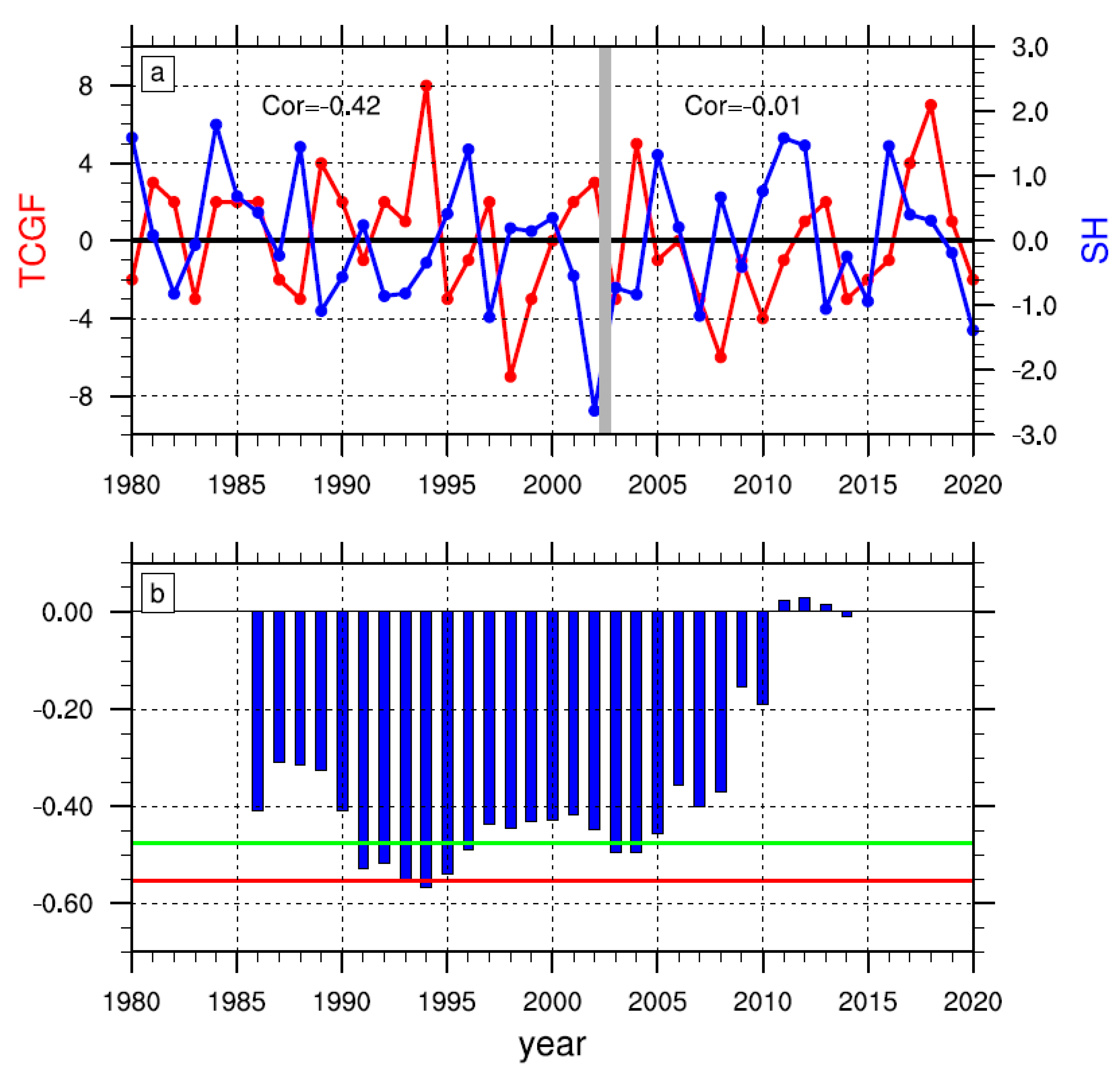
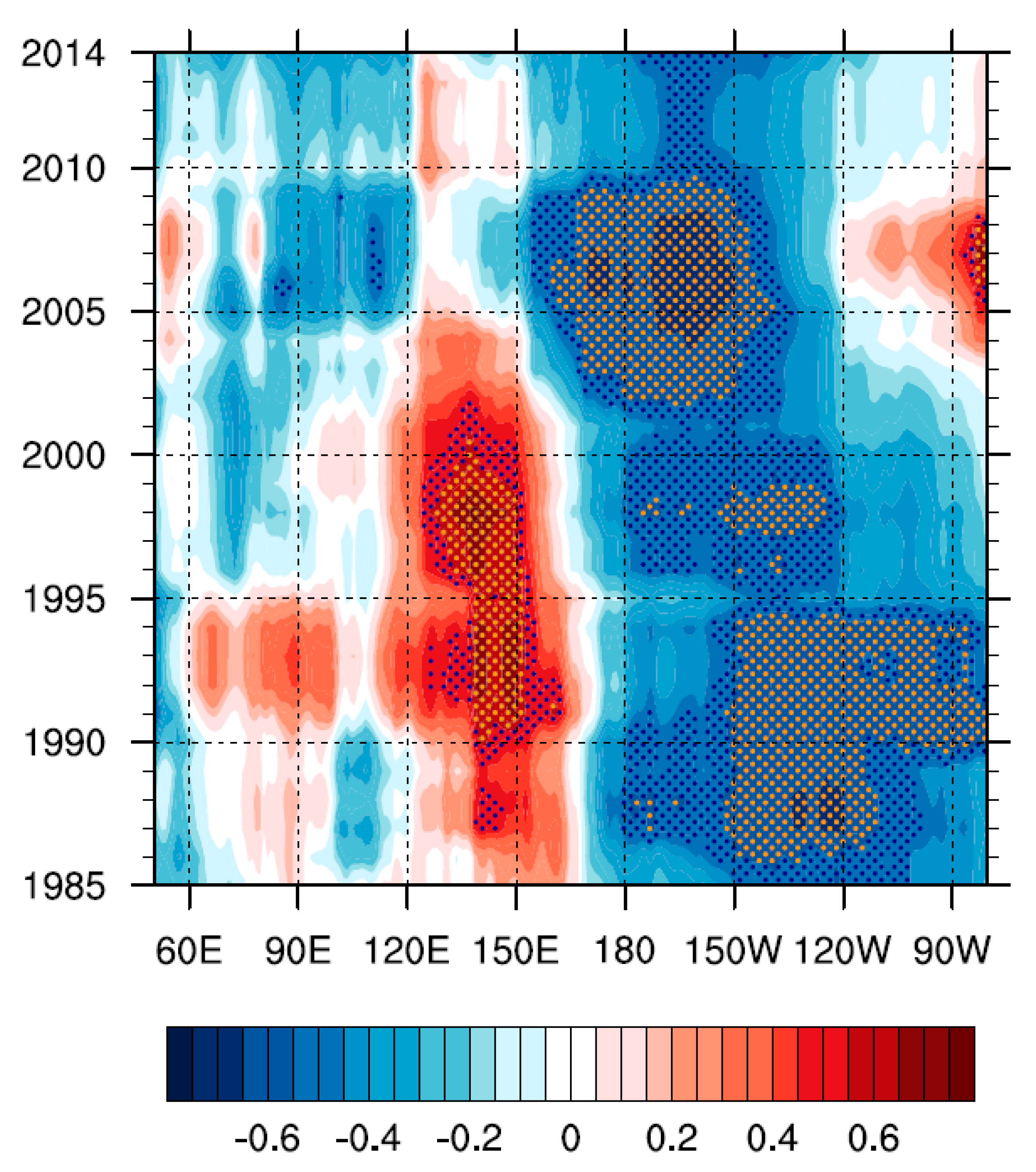
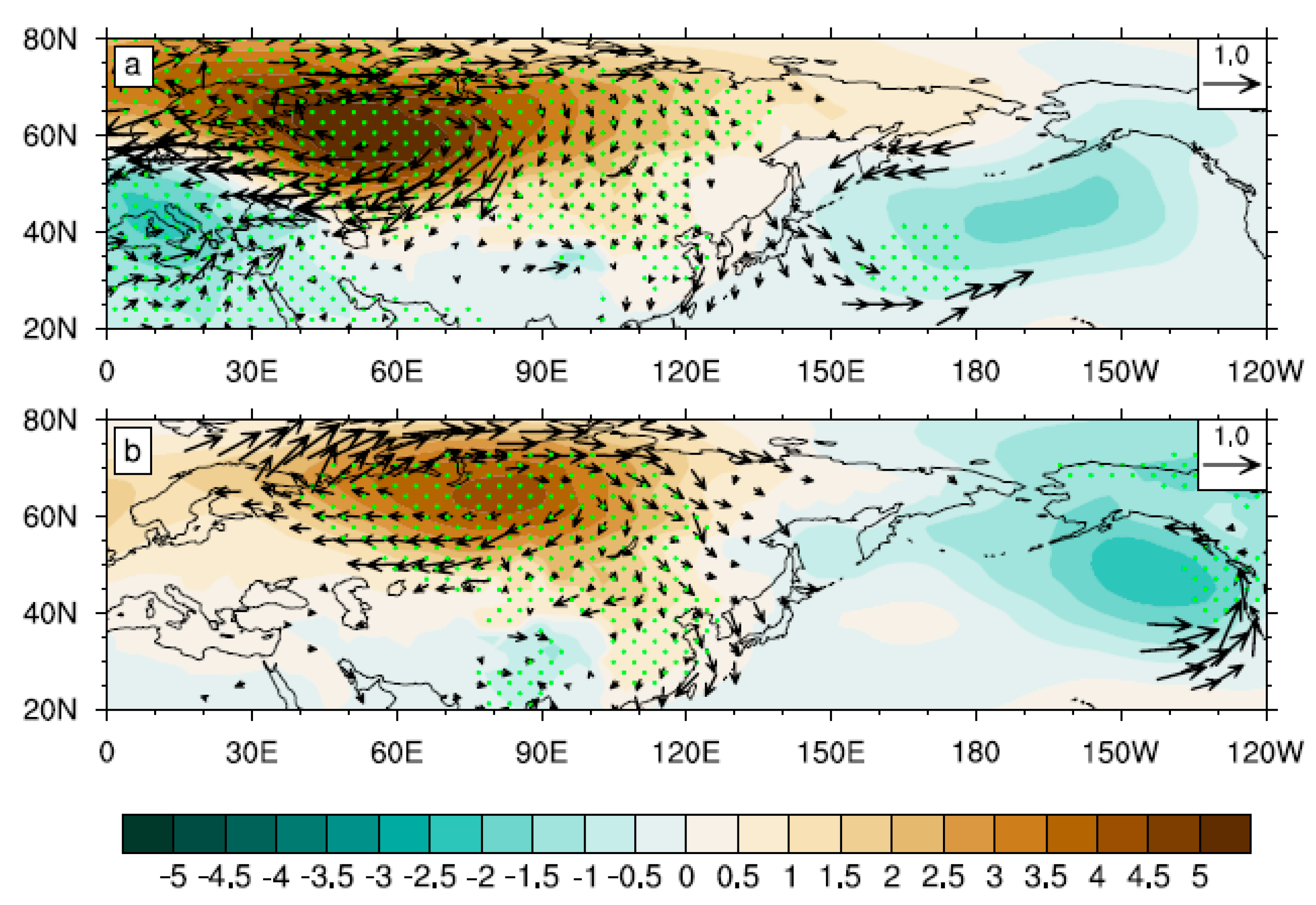
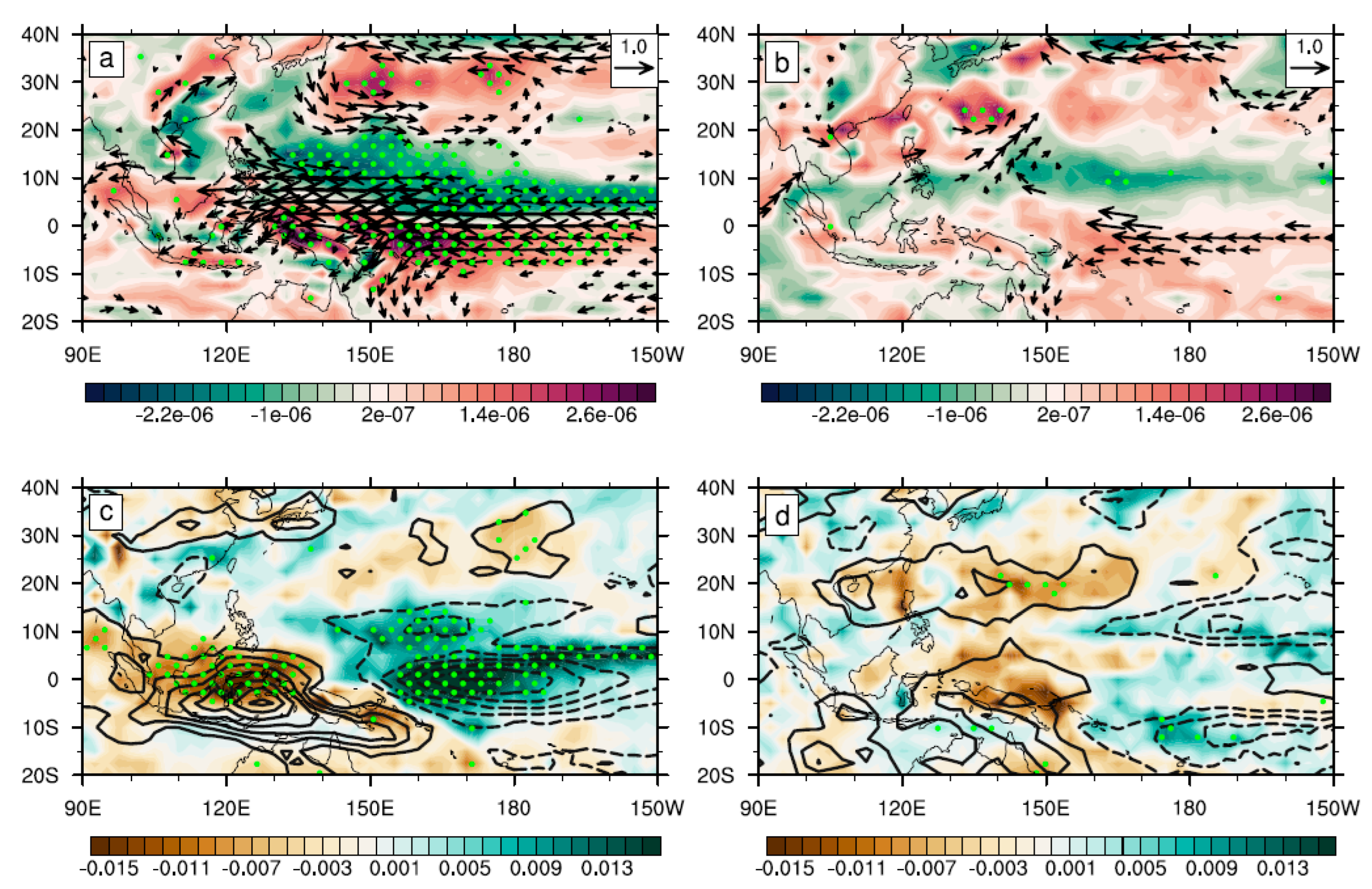
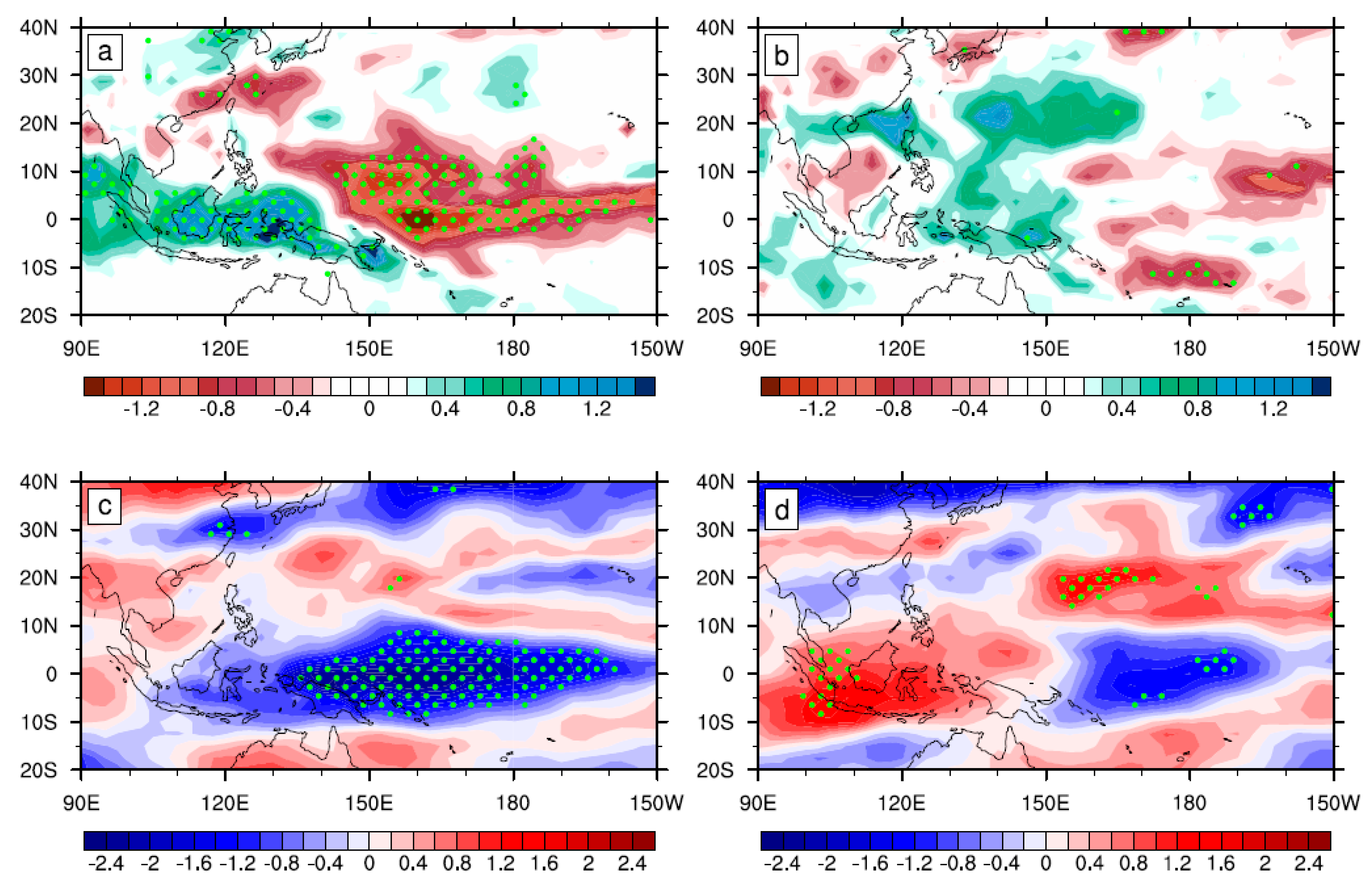
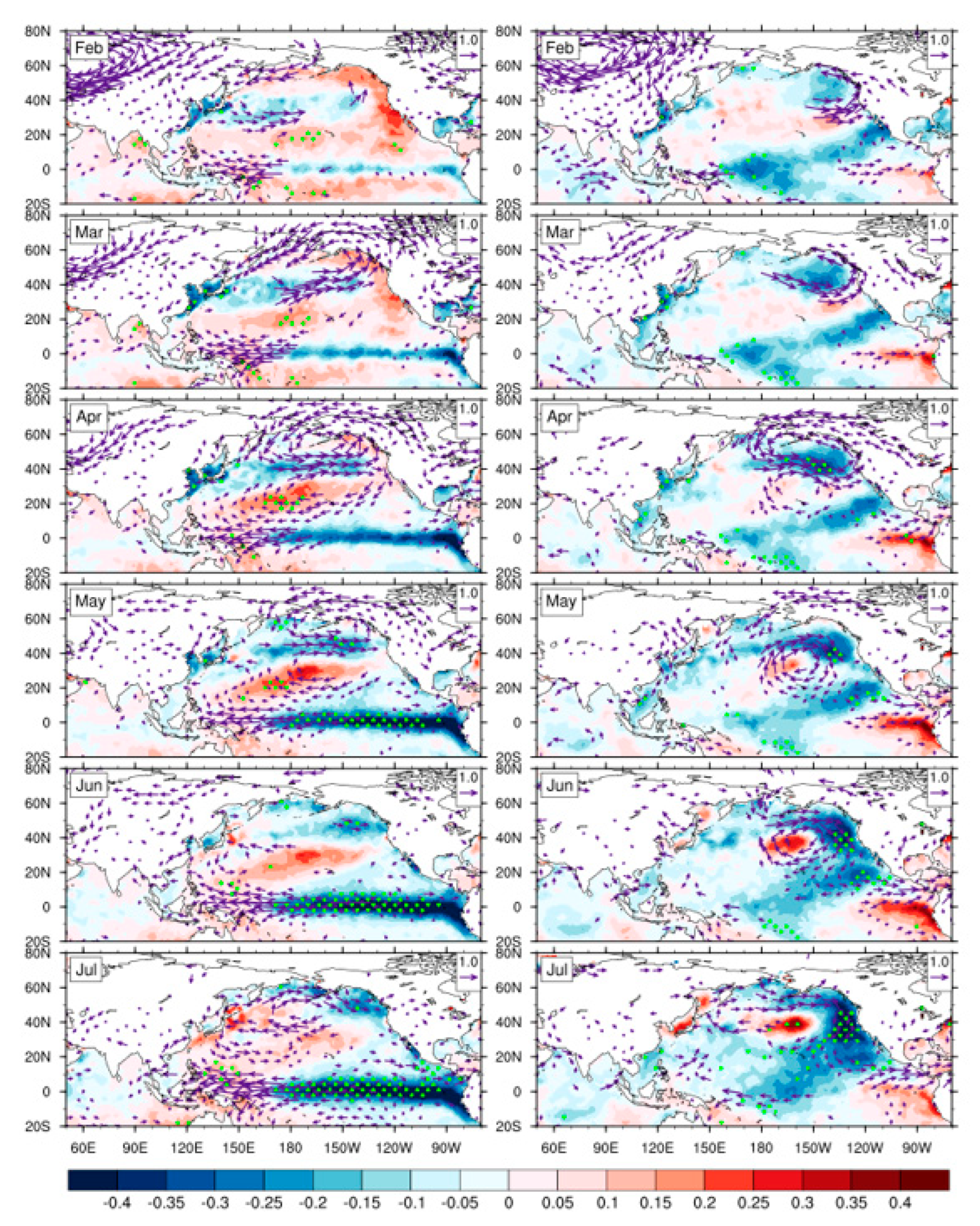
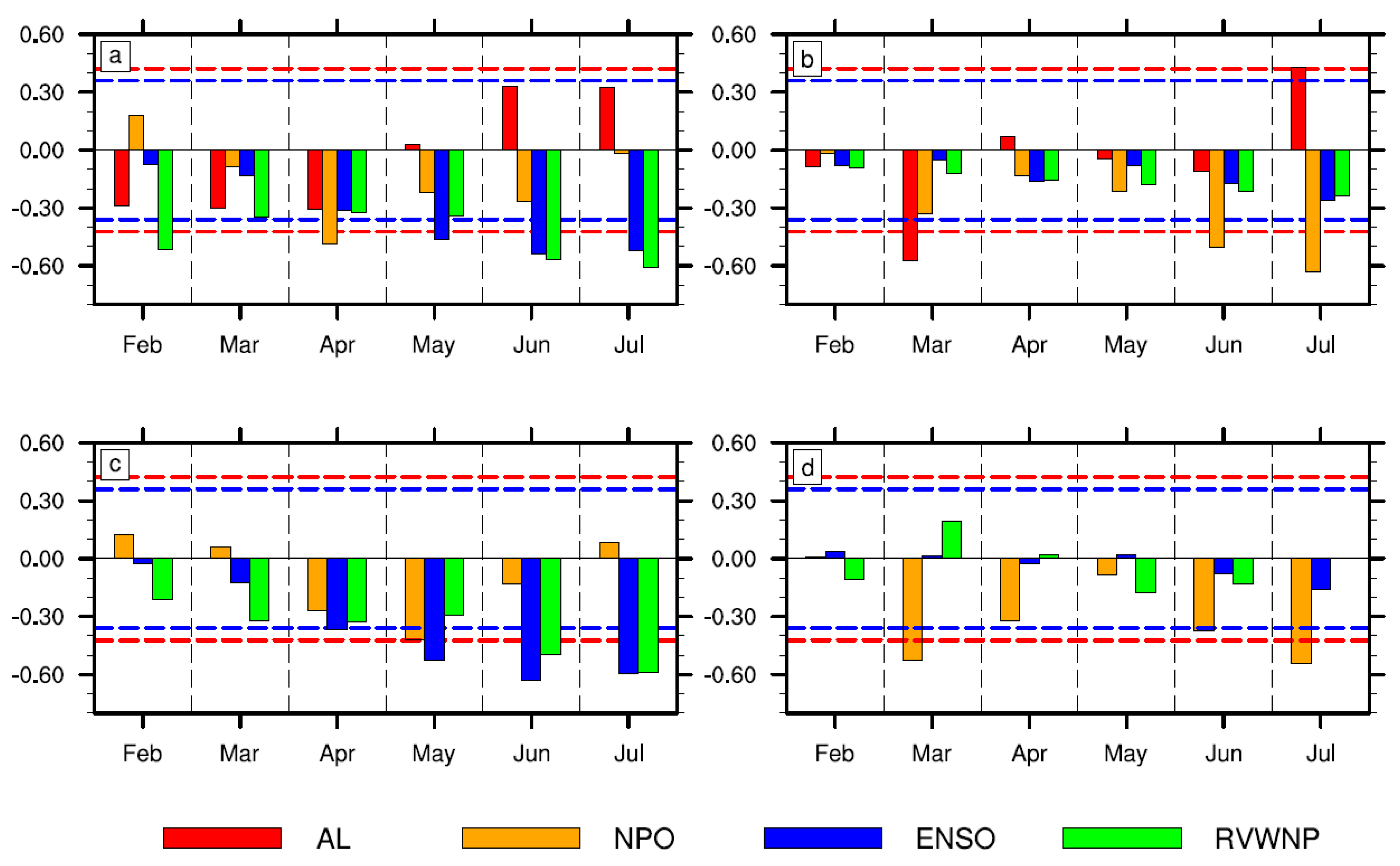
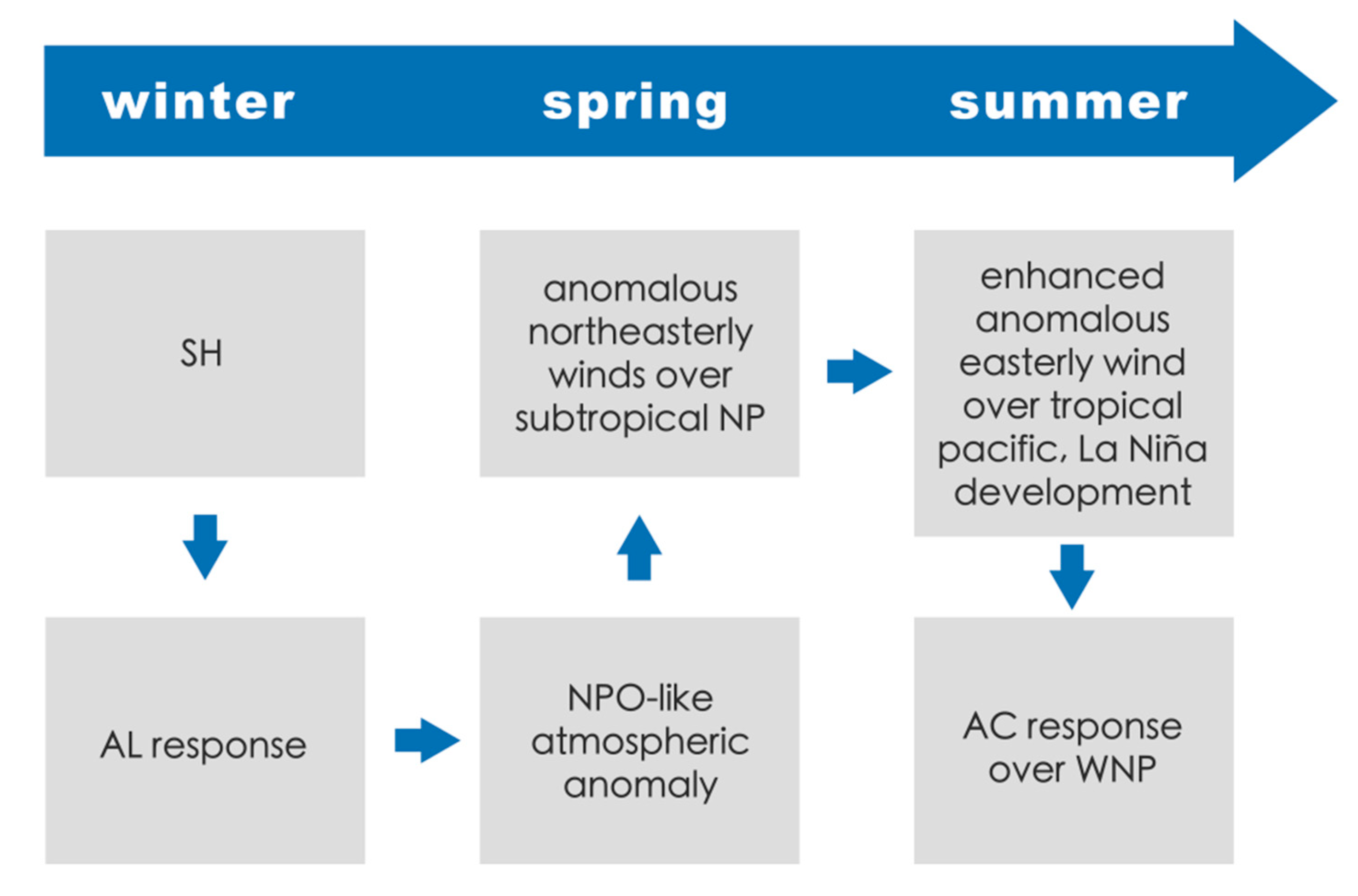
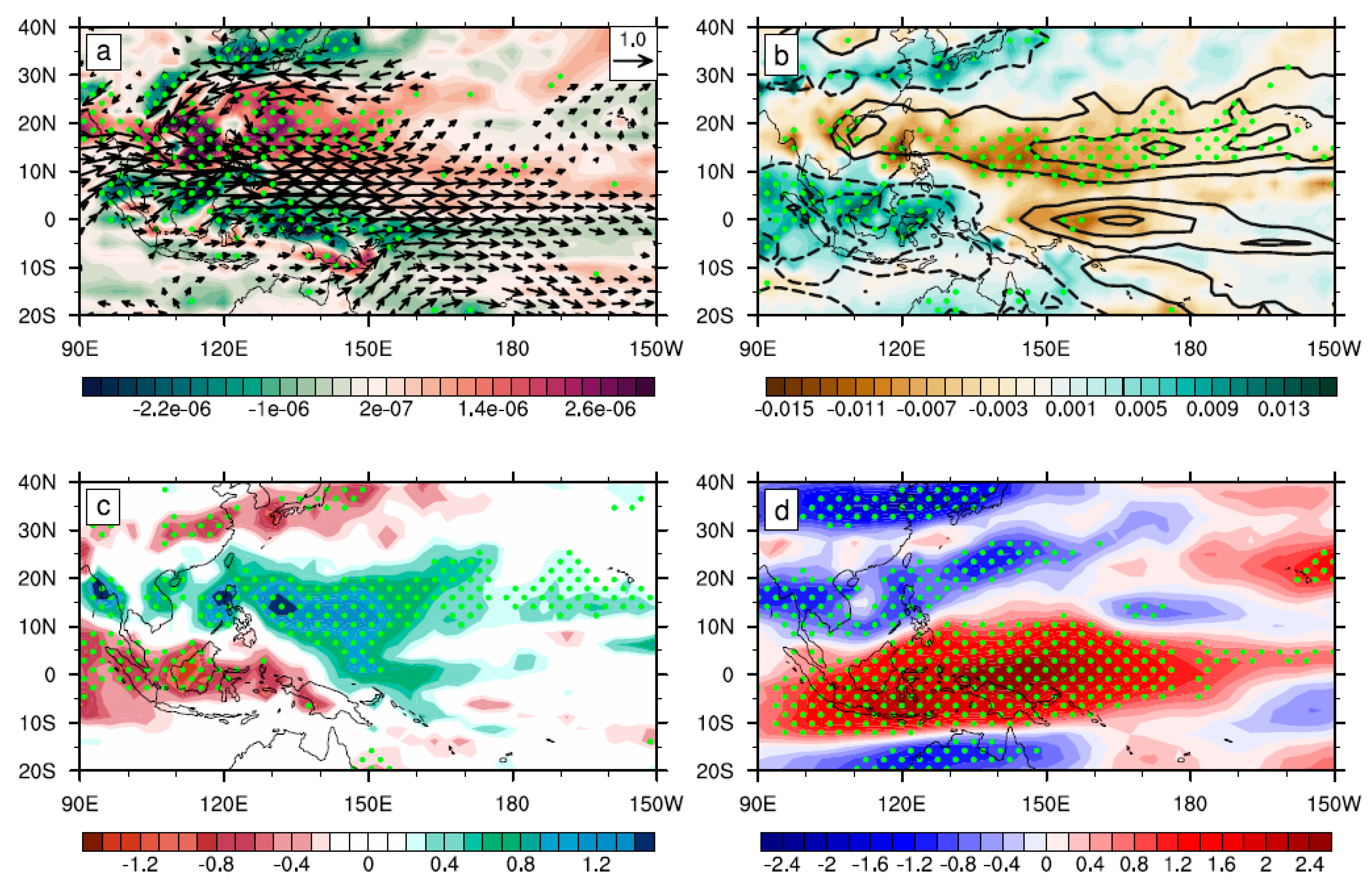
Publisher’s Note: MDPI stays neutral with regard to jurisdictional claims in published maps and institutional affiliations. |
© 2022 by the authors. Licensee MDPI, Basel, Switzerland. This article is an open access article distributed under the terms and conditions of the Creative Commons Attribution (CC BY) license (https://creativecommons.org/licenses/by/4.0/).
Share and Cite
Gong, Y.-F.; Zhou, F.; Wang, C.; Shi, J. Interdecadal Change in the Relationship between the Winter Siberian High and Summer Tropical Cyclone Genesis Frequency over the Western North Pacific. Atmosphere 2022, 13, 1342. https://doi.org/10.3390/atmos13091342
Gong Y-F, Zhou F, Wang C, Shi J. Interdecadal Change in the Relationship between the Winter Siberian High and Summer Tropical Cyclone Genesis Frequency over the Western North Pacific. Atmosphere. 2022; 13(9):1342. https://doi.org/10.3390/atmos13091342
Chicago/Turabian StyleGong, Yi-Fei, Fang Zhou, Chao Wang, and Jian Shi. 2022. "Interdecadal Change in the Relationship between the Winter Siberian High and Summer Tropical Cyclone Genesis Frequency over the Western North Pacific" Atmosphere 13, no. 9: 1342. https://doi.org/10.3390/atmos13091342
APA StyleGong, Y.-F., Zhou, F., Wang, C., & Shi, J. (2022). Interdecadal Change in the Relationship between the Winter Siberian High and Summer Tropical Cyclone Genesis Frequency over the Western North Pacific. Atmosphere, 13(9), 1342. https://doi.org/10.3390/atmos13091342






